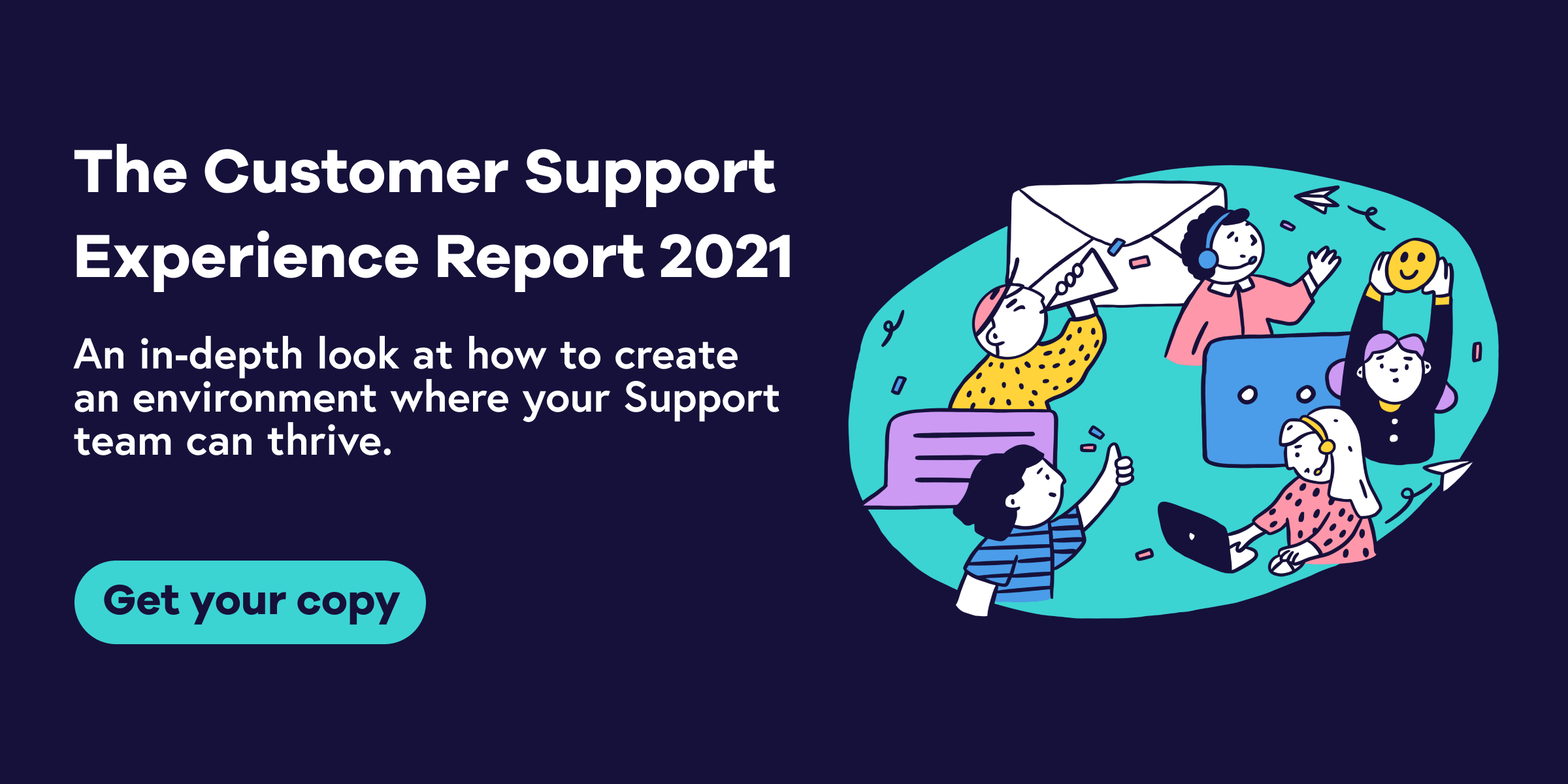Helpful, friendly customer service shouldn’t be seen as “optional” by your business. It has serious implications for whether customers will return to your company and spread the word about your products. According to a Qualtrics study, 95% of consumers who rate a company’s customer experience as “very good” are likely to recommend the company.
To offer high-quality support, you’ll need a customer service strategy — a plan for handling customer interactions. It should cover:
- The channels you use to provide customer service
- Goals and key performance indicators (KPIs) for your customer service team
- Best practices for meeting customers’ needs at all stages of the customer journey
To differentiate your brand, learn how to provide an excellent customer service experience at every stage of the customer journey — not just when they first sign up for your product or when it’s renewal time.
Onboarding: Answer questions so customers reach their “aha” moment
Onboarding is the first stage of the customer journey when a new customer sets up your product and uses it for the first time. The process often involves product walk-throughs or setup guides for new users to complete.
During the onboarding stage, your customer service team should be on hand to identify customers who get stuck during product setup and answer any queries they may have about how to start using your product. Your team should also monitor self-service and onboarding metrics to track how new customers are using the product and getting value from it, including:
- Completion rate — this measures how many people complete a specific goal in your onboarding process
- Knowledge base views — this measures how many customers view the self-service support articles on your website so that you can identify the most common customer issues. You can create a dedicated onboarding section within your knowledge base to give you visibility into the challenges your new customers face during the onboarding process
- Ratio of knowledge base views vs tickets submitted — this measures how well your customers can find the help they need via self-service channels and how often your customers visit your knowledge base but end up contacting your support team anyway. By tracking which knowledge base articles they visit before contacting you, you can segment incoming tickets from new customers in the onboarding process, and existing customers
To help new users, keep a record of the most commonly asked questions during onboarding and check whether the most popular knowledge base pages cover these topics. This will help your customer service team improve your self-service support by determining whether there are gaps in your knowledge base or if the content needs to be more accessible.
Your customer service team should also take detailed notes about interactions with new customers in your customer relationship management software (CRM). This record of questions, concerns, and priorities will help support agents provide relevant, personalized service for individual customers as they become more familiar with your product.
Adoption: Check in regularly to build a strong customer relationship
The adoption stage is when your customer continues using your product after completing onboarding. In this stage of the customer journey, the most important focus for your customer service team is to provide ongoing support as and when it’s needed.
To create a consistent experience for your customers, set a cadence for regular contact between your customer service team and your customers. This will help you build strong long-term relationships and keep track of how customers feel about your product. The cadence and type of contact will vary depending on your product and the type of customer. You might set up:
- Monthly calls with high-value customer accounts to provide a “white glove” level of customer service
- Quarterly calls with the rest of your accounts to check in with your main point of contact
- Quarterly customer satisfaction surveys to measure customer happiness on an ongoing basis
Your customer service team should also put together a health check process to identify customers who may be at risk of churning. Analyze product usage data to identify users who aren’t getting enough value from your product and use Customer Satisfaction (CSAT) scores after each support interaction to measure how well your customer service team handles customer queries. A user who isn’t using your product as frequently as they used to, and gives low CSAT scores after a support interaction, is a potential churn risk at the end of their contract.
Retention: Support customers during the renewal process
In the retention stage, you’ll want to take steps to win over customers who are having second thoughts about your product or company and considering churning. Your customer service team at this point has four main priorities:
- Identifying customers who are at risk of churning by analyzing the data mentioned in the last section: product usage data, customer satisfaction survey results, and notes from customer check-ins
- Identifying customers who are a lower churn risk. These happy customers will require less effort to retain, but shouldn’t be overlooked by your customer service team
- Re-engaging at-risk customers to reduce churn by helping them with their product challenges and reminding them of the value they get from using your product
- Providing a quality offboarding experience for customers who decide not to renew. Identify common themes and reasons for churning so you can improve the experience for future customers
Document your retention processes so that any member of your service team can effectively support customers. This should include:
- How to prioritize tickets: each company will have its own process for prioritizing support tickets. For example, some companies may want to respond to highest-value customers first, while others focus on customers closest to their renewal date. Documenting this will make it easy for your customer service team to prioritize their own ticket queue and better manage their own workload.
- Re-engagement processes: When should you reach out to at-risk customers? What questions should you ask them to understand their needs and feelings about your product? What convinced a customer to renew their contract? What didn’t work and led to a customer churning anyway? Include example emails or call recordings so team members can see what good-quality re-engagement comms look like
- Offboarding processes: Map out all the steps your customer needs to go through from when they cancel to when they stop using your product. Your offboarding process is the last impression you’ll make on your customer, so provide training to help your customer service team provide high-quality service right to the end
Detailed documentation will help you provide a consistent experience for all your customers at the retention stage, whether they renew or churn.
Expansion: Put customer needs first when upselling
The expansion stage is when a customer has outgrown their existing plan, and they upgrade to a more expensive option with added capacity, features, or users. This phase is just as important as the onboarding stage — in fact, you might think of it as the “re-onboarding” stage of the customer life cycle.
Your customer service team should take a customer-centric approach to upsells, focusing on two main areas: working with customers to understand if expanding their account is a good fit for them and then helping them get value from their upgraded account as quickly as possible.
To identify customers who are a good fit for account expansion, your team will need to have a clear understanding of your users’ business goals with your product. Customer success expert Lincoln Murphy describes this as “logical account expansion.” If you understand what your customer is trying to achieve with your product, and your product helps them achieve their goals, “then getting the customer to consume more, buy an add-on, or otherwise expand their use is actually what’s necessary to continue on the path to success,” he says.
Document how to identify customers who are a good fit for an upsell, and make sure you have a clear pricing structure, so customers know what the upsell includes, and how much they’ll pay for it. Your customer service team should also document best practices for teaching customers about the value of their new or upgraded features. This re-onboarding could involve mini walk-throughs or demos to familiarize customers with the new features or running regular calls with the clients as they add new team members into your product.
Advocacy: Find customers who will recommend you to their network
The advocacy stage of the customer journey is when happy, loyal customers are recommending your brand to their network. It’s the phase when you finally start to reap the benefits of providing great customer service.
The main focus of your customer service strategy at this stage should be to encourage happy customers to provide reviews, refer friends and colleagues, and take part in case studies. Your customer service team should look for customers who:
- Are regular users of your product
- Have seen positive results from using your product
- Use your product in a way that other potential customers can relate to
- Provide consistently high CSAT scores and customer satisfaction survey responses
- Have directly told your customer service team that they love your product
Document your process for identifying good-fit customers who are likely to refer you or provide a positive review. This resource will help your customer service reps avoid wasting time chasing customers who aren’t engaged with your product or willing to recommend it. Your customer service team should also create email templates for requests to leave reviews or participate in case studies.
Adjust your customer service strategy as needed
The different stages of the customer journey may require different amounts of involvement from your customer service team — and that effort will likely change over time as your company matures, grows, and puts different processes in place. Track the metrics mentioned in this post to understand which stages of the customer journey need the most effort from your customer service team.
From there, you can adjust your customer service strategy to give extra care for stages that are falling behind while still providing ongoing support for all users.


